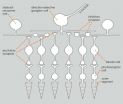(Press-News.org) Scientists are untangling how the tiniest pollution particles – which we take in with every breath we breathe – affect our health, making people more vulnerable to cardiovascular and respiratory problems. While scientists know that air pollution can aggravate heart problems, showing exactly how it does so has been challenging.
In a study published recently in the journal Environmental Health Perspectives, scientists showed that in people with diabetes, breathing ultrafine particles can activate platelets, cells in the blood that normally reduce bleeding from a wound, but can contribute to cardiovascular disease.
The investigators from the University of Rochester Medical Center studied people with Type 2 diabetes so they could track changes in the blood in response to breathing ultrafine particles, specifically in a group of people who are prone to heart disease. Just last week, other scientists announced in the New England Journal of Medicine that diabetes doubles the risk that a person will die of cardiovascular disease. For the Rochester study, for safety reasons, participants in the study had no clinical evidence of heart or vascular disease.
"What's interesting about our new results is not so much what it shows about people with diabetes," said first author Judith Stewart, M.A. "Rather, it gives us details more generally about how the body's vascular system responds to exposure to ultrafine particles. It's such a complex process to understand – it's as if someone gave you a haystack and told you to look for something tiny, but you had no idea what you were actually looking for."
In the study, Stewart and corresponding author Mark Frampton, M.D., tried to tease out some of the details about how air pollution makes bad things happen in the body. It's an area that Frampton, a pulmonary specialist who does research and who treats patients with lung disease, has studied for more than 25 years.
The team looked at ultrafine particles, which are almost unimaginably small. If a human hair were the width of a football field, the largest ultrafine particles would be about the size of a baseball. While cars and trucks are the most common source, they also come from cooking on a stove or running household devices like vacuum cleaners. Coal-burning power plants are another common source, releasing chemicals into the air that can lead to particle formation.
The team studied 19 people with diabetes, measuring how their bodies adjusted to breathing in either highly purified air or air that included ultrafine particles.
Scientists found that after exposure to the particles, participants had higher levels of two well known markers of cardiovascular risk, activated platelets and von Willebrand factor. Both play a major role in the series of events that lead to heart attacks. Platelets, for instance, can stick to fatty buildups or plaques within the blood vessels and cause a clot, blocking blood flow to heart muscle.
"Platelets are the critical actor at the actual moment of a heart attack," said Frampton. "When a plaque ruptures, platelets glom onto it, forming a large clot. Normally, of course, platelets do not block blood flow and aren't a problem. Our findings indicate that when someone is exposed to air pollution, the platelets become activated, which would make them more likely to trigger a heart attack."
The particles used in the study were relatively "clean" ultrafine particles, made of pure carbon. Scientists have done other studies looking at the effects of ultrafine particles in people, but those studies usually have included other materials, such as gases and other particles, and have often been done with higher concentrations. Frampton and Stewart studied a concentration of particles that was 50 micrograms per cubic meter, which is lower than most studies though still higher than what most people are normally exposed to while breathing everyday air.
"More than anything else, our study offers some direction about where to look for the molecular mechanism or link between air pollution and cardiovascular problems," said Frampton, who is professor in the Pulmonary and Critical Care Division of the Department of Medicine and a professor in the Department of Environmental Medicine.
"The risk of these particles to healthy individuals is really not much," he added. "Most people wouldn't be affected at all. But people with diabetes or other chronic conditions like asthma should heed the advice to stay inside when air quality is poor. These patients really need to control many factors, and one of them is their exposure to pollution."
###
In addition to Frampton and Stewart, other authors from the University include David Chalupa, Lauren Frasier, Li-Shan Huang, Erika Little, Steven Lee, Richard Phipps, Anthony Pietrapaoli, Mark Taubman, and Mark Utell. Robert Devlin of the U.S. Environmental Protection Agency also contributed. The work was funded by the U.S. Environmental Protection Agency and the National Institute of Environmental Health Sciences.
Pinpointing air pollution's effects on the heart
2011-03-10
ELSE PRESS RELEASES FROM THIS DATE:
Study shows how plants sort and eliminate genes over millennia
2011-03-10
WEST LAFAYETTE, Ind. - Hybrid plants with multiple genome copies show evidence of preferential treatment of the genes from one ancient parent over the genes of the other parent, even to the point where some of the unfavored genes eventually are deleted.
Brian Dilkes, an assistant professor of genetics at Purdue University, worked with a team of scientists at the University of California Davis and University of Southern California to study the genome of Arabidopsis suecica, a hybrid species with four chromosome sets formed tens of thousands of years ago from a cross between ...
What's in a name? Broadening the biological lexicon to bolster translational research
2011-03-10
So-called model organisms have long been at the core of biomedical research, allowing scientists to study the ins and outs of human disorders in non-human subjects.
In the ideal, such models accurately recapitulate a human disorder so that, for example, the Parkinson's disease observed in a rat model would be virtually indistinguishable from that in a human patient. The reality, of course, is that rats aren't human, and few models actually faithfully reflect the phenotype of the disease in question. Thus, in the strictest sense of the word, many "models" aren't truly ...
Novel method could improve the performance of proteins used therapeutically
2011-03-10
FINDINGS: Whitehead Institute scientists have created a method that uses the enzyme sortase A to site-specifically modify proteins. Using this technique, researchers were able to increase potency, slow the metabolism, and improve thermal stability of several proteins, including interferon alpha 2 (IFN-alpha 2) and granulocyte colony-stimulating factor 3 (GCSF-3). IFN-alpha 2 is used to treat a variety of diseases, including leukemia, melanoma, and chronic hepatitis C, while GCSF-3 (known as filgrastim and marketed as Neupogen®) is administered to patients with neutropenia.
RELEVANCE: ...
First international index developed to predict suicidal behavior
2011-03-10
Although thousands of people commit suicide worldwide each year, researchers and doctors do not have any method for evaluating a person's likelihood of thinking about or trying to commit suicide. An international group of scientists, in which the Hospital del Mar Research Institute (IMIM) has participated, has devised the first risk index in order to prevent suicides.
"It is of key importance to identify suicidal thoughts among people at increased risk. The most important contribution that our study has made is an international risk index to estimate the likelihood of ...
More reasons to be nice: It's less work for everyone
2011-03-10
A polite act shows respect. But a new study of a common etiquette—holding a door for someone—suggests that courtesy may have a more practical, though unconscious, shared motivation: to reduce the work for those involved. The research, by Joseph P. Santamaria and David A. Rosenbaum of Pennsylvania State University, is the first to combine two fields of study ordinarily considered unrelated: altruism and motor control. It is to be published in a forthcoming issue of Psychological Science, a journal of the Association for Psychological Science.
"The way etiquette has been ...
Rutgers researchers identify materials that may deliver more 'bounce'
2011-03-10
NEW BRUNSWICK, N.J. – Rutgers researchers have identified a class of high-strength metal alloys that show potential to make springs, sensors and switches smaller and more responsive.
The alloys could be used in springier blood vessel stents, sensitive microphones, powerful loudspeakers, and components that boost the performance of medical imaging equipment, security systems and clean-burning gasoline and diesel engines.
While these nanostructured metal alloys are not new – they are used in turbine blades and other parts demanding strength under extreme conditions – ...
When leukemia returns, gene that mediates response to key drug often mutated
2011-03-10
(MEMPHIS, Tenn. – March 9, 2011) Despite dramatically improved survival rates for childhood acute lymphoblastic leukemia (ALL), relapse remains a leading cause of death from the disease. Work led by St. Jude Children's Research Hospital investigators identified mutations in a gene named CREBBP that may help the cancer resist steroid treatment and fuel ALL's return.
CREBBP plays an important role in normal blood cell development, helping to switch other genes on and off. In this study, researchers found that 18.3 percent of the 71 relapsed-ALL patients carried alterations ...
Gene variant influences chronic kidney disease risk
2011-03-10
A team of researchers from the United States and Europe has identified a single genetic mutation in the CUBN gene that is associated with albuminuria both with and without diabetes. Albuminuria is a condition caused by the leaking of the protein albumin into the urine, which is an indication of kidney disease.
The research team, known as the CKDGen Consortium, examined data from several genome-wide association studies to identify missense variant (I2984V) in the CUBN gene. The association between the CUBN variant and albuminuria was observed in 63,153 individuals with ...
New microscope decodes complex eye circuitry
2011-03-10
VIDEO:
Ganglion cells preferentially form synapses with those amacrine cells whose dendrites run in the direction opposite -- seen from the ganglion cell - to the preferred direction of motion (amacrine...
Click here for more information.
The sensory cells in the retina of the mammalian eye convert light stimuli into electrical signals and transmit them via downstream interneurons to the retinal ganglion cells which, in turn, forward them to the brain. The interneurons ...
Physicists measure current-induced torque in nonvolatile magnetic memory devices
2011-03-10
ITHACA, N.Y. - Tomorrow's nonvolatile memory devices – computer memory that can retain stored information even when not powered – will profoundly change electronics, and Cornell University researchers have discovered a new way of measuring and optimizing their performance.
Using a very fast oscilloscope, researchers led by Dan Ralph, the Horace White Professor of Physics, and Robert Buhrman, the J.E. Sweet Professor of Applied and Engineering Physics, have figured out how to quantify the strength of current-induced torques used to write information in memory devices ...


